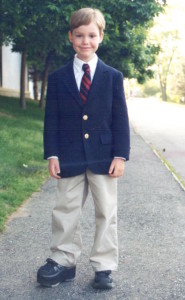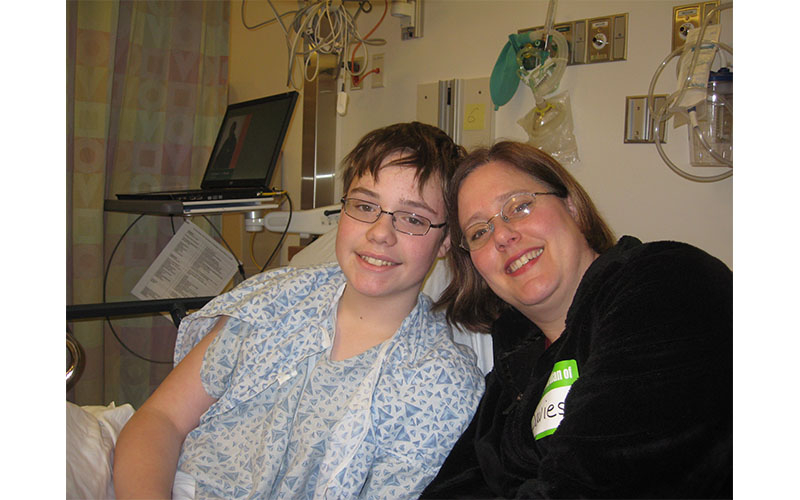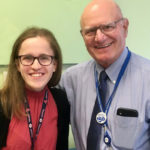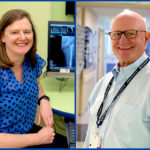George the unstoppable conquers leg-length discrepancy

George Davies, a senior at Bancroft School in Worcester, Massachusetts, faces every challenge, every obstacle and every situation with a sense of what’s possible. He rows varsity crew, plays the electric guitar, and after two years of independent research he’s off to Scotland’s University of St. Andrews to study biochemistry.
Dr. James Kasser, Boston Children’s Hospital’s surgeon-in-chief, diagnosed George when he was 3 months old with fibular hemimelia, a rare genetic absence of the fibular bone and a condition which results in the affected leg growing at a slower rate than normal. Without treatment, George’s right leg would have been six inches shorter than his left.
His parents had two options: amputate George’s foot and have him fitted with a series of prostheses throughout his life or sign him up for a series of limb-lengthening operations.
Jen and Paul Davies did their homework. They spoke with other families whose children had undergone leg-lengthening operations. “The apparatus is dramatic and scary looking, but the kids seemed fine. We decided it was the best option for George,” recalls Jen. The Davies family opted for a series of limb-lengthening surgeries with Dr. Kasser.
George the unstoppable toddler

When George was an infant, he was fitted with a small shoe to hold his foot in position, and the family travelled to Boston Children’s on a regular basis to work with physical therapist Nicole Polizzi to assist with crawling and walking.
“We thought he’d crawl or walk later than other babies, but as it turned out he was ahead of the curve,”says Jen. “Nothing was going to stop him.”
As he grew, George contended with an increasing leg-length discrepancy between his right and left legs. In kindergarten, he had an operation to lengthen his Achilles tendon and was fitted with a leg brace and a lift on his shoe. The family did daily physical therapy to keep the ankle supple and strong. Throughout it all, George never stopped running and playing with his friends.
George’s first limb-lengthening surgery
The family scheduled George’s first leg-lengthening surgery in the summer before fourth grade. It was a femoral lengthening. The Ilizarov technique was used, and four rods were screwed into his femur and attached to an external fixator. The femur was surgically broken, and screws in the device were slowly turned, which increased the gap at the break. George’s body did the miraculous job of creating new bone to fill in the space.
Limb lengthening
“The whole family has to be ready for lengthening,” explains Jen.
With external devices, infection is a major concern as the pins and rods inserted provide a path right into the bone, so keeping the area around the pins clean is a critical infection-prevention measure. Families need to keep an eye out for any signs of infection like fever or redness around the pins.
The screws in the external leg-lengthening device are turned several times a day to lengthen the bone, but the fascia, muscles and tendons, require regular physical therapy to stretch and keep pace with the lengthening.
The new internal fixator significantly reduces the infection risk posed by external devices but still requires months of healing and lengthening.
Every week, the family visited Boston Children’s Orthopedic Center for an X-ray and an appointment with Dr. Kasser and his nurse Paula Donahue. A friendship was born.
“We couldn’t have gone through this process without the care and constant support of Dr. Kasser and Paula,” says Jen. “It was never just about the leg — it was always about the whole child. Every time Dr. Kasser walked through the door, he had a smile on his face. And every question we asked from, ‘Can George ride a bike?’ to, ‘Can George go to camp?’ his response was the same. ‘Let’s make it possible.’”
Then Dr. Kasser had a question for George. Would he be willing to speak with other families about what it was like to go through a leg-lengthening procedure?
The answer was an immediate “yes.”
“George has spoken to many families over the years,” says Jen. “It has been wonderful for us to give back in this way. I remember very clearly how helpful it was for us to see a child with a lengthening device and to speak with their parents. We have always been happy to return the favor.”
George discovers his inner comedian
When George was 11, he had a second leg lengthening, this time using a Taylor Spatial device to lengthen the tibia bone. Seventeen color-coded rods and pins were attached to a circular frame around George’s lower leg. Every week, the family returned to Boston Children’s for an X-ray, a meeting with Dr. Kasser and Paula to monitor progress on the tibial lengthening.

“The technology had developed, and I was on the forefront of what was happening,” says George.
He became an expert and a comic. “People would see the frame and approach George to ask if he was OK,” says Jen. “He loved to spin some wild story about an encounter with a bear, or say that he had cut himself shaving and watch the concern turn to laughter. He would then go on to explain all about the technique and how he was growing new bone.”
This may explain George’s affinity for science and chemistry, which became apparent during his sophomore year of high school. “I took chemistry and thought this is the best thing ever,” George says. That led to several science-related internships and a passion for genetics, partially fueled by his own interesting genetic history.
George the medical device pioneer
For his last leg lengthening, George partnered with Dr. Kasser to become a medical pioneer.
When George was 14, Dr. Kasser approached the family about being the first patient at Boston Children’s to use a new limb-lengthening device — a fully internal device without an external fixator — called the PRECICE Nail. George’s risk for fracture and infection would be reduced, and he would recover faster.
“We were on board right away,” says Jen. The new device was surgically inserted into George’s femur and an osteotomy (a surgery to cut the bone) performed.

Three times a day, George would place an external remote controller onto his leg and rotate the internal magnets to telescope the implant at the osteotomy site. Again, George’s body did the important work of generating new bone.
“It was fascinating to see on the weekly X-rays the feather-like cells filling in the gap between the bone. Every week the material would become denser, and eventually the space was completely filled with new bone,” says George.
“The whole process using the PRECICE Nail was a night-and-day improvement over the previous procedures,” says Jen. “There was very little wound care and therefore very little concern about infection. The lengthening was easy to perform, and the recovery time was much quicker.”
Adds George, “It was cool to be the first person at Boston Children’s to have this procedure done.”
In October 2015, George spoke at the Arthritis Foundation dinner honoring Dr. Kasser.
“I stand here today with two legs the same length, thanks to Dr. Kasser, but I am grateful to him for so much more. People tell me all the time that I have a positive attitude. Perhaps that’s because, thanks to Dr. Kasser, I believe that anything is possible.”
After nine surgeries, George’s leg lengthening is complete and both legs are the same length. As he looks ahead to the next stage of life, one thing is certain: there will be no stopping George.
Learn more about the Limb Lengthening and Reconstruction Program, Lower Extremity Program and how we treat leg-length discrepancy.
Related Posts :
-

Leg lengthening and hip surgeries inspire a career
Lauren Schoeller was in eighth grade when she decided to become an orthopedic surgeon. She had by then had multiple ...
-

Limb-lengthening surgery: A look at the pros and cons
Limb length discrepancies, a leg or arm that’s shorter than the other, can occur for a number of reasons. ...
-

A malunion fracture, baseball, and M&M cookies: Tyler’s story
Tyler Weygand loves baseball, and he’s good at it. Good enough that few balls ever get past him in ...
-

One family, two very different clubfoot experiences
Theresah Boateng and her daughter Eno Agyapomaa Agyemang both have strong wills and outgoing personalities. Both were born with a ...





